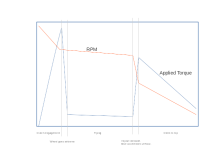I've been looking around for a controller that might be able to maintain a fixed RPM decay rate even as load varies.
ie. from high RPM the throttle is closed, the motor should maintain a more or less constant RPM decay rate even if the load is totally removed then suddenly increased. Obviously within the limits of the motor & controller - if the load is too high the RPM will of course drop suddenly.
Effectively the controller needs to take control of the throttle input to respond to excessive decrease in RPM.
In a totally ideal world it would be possible to:
Adjust the maximum current that the controller will deliver to maintain RPM.
Adjust the current ramping response (so the response can be more or less instantaneous to changes in load.)
Adjust a time threshold for the response to decay (ie in response to an instant large load increase the current would spike to maintain RPM, but then would decay over the time constant.
Set up separate attack (rising RPM) and decay profiles.
My goal is to somewhat electrically simulate the effect of a flywheel.
I'd hoped that some of the scripting ability in Silixcon controllers might be able to do at least some of this, but after spending time reading their resources I'm not so sure it could. Still researching.
My guess is that this is likely so far out of mainstream needs that it's not going to be available without some moderately serious software development by a controller manufacturer.
Oh, and if that same controller had the ability to set an 'idle' rpm that would be gold. And if that idle rpm could have it's current limit manipulated (effectively to set a 'stalling load' theshold) that would be ... platinum?
ie. from high RPM the throttle is closed, the motor should maintain a more or less constant RPM decay rate even if the load is totally removed then suddenly increased. Obviously within the limits of the motor & controller - if the load is too high the RPM will of course drop suddenly.
Effectively the controller needs to take control of the throttle input to respond to excessive decrease in RPM.
In a totally ideal world it would be possible to:
Adjust the maximum current that the controller will deliver to maintain RPM.
Adjust the current ramping response (so the response can be more or less instantaneous to changes in load.)
Adjust a time threshold for the response to decay (ie in response to an instant large load increase the current would spike to maintain RPM, but then would decay over the time constant.
Set up separate attack (rising RPM) and decay profiles.
My goal is to somewhat electrically simulate the effect of a flywheel.
I'd hoped that some of the scripting ability in Silixcon controllers might be able to do at least some of this, but after spending time reading their resources I'm not so sure it could. Still researching.
My guess is that this is likely so far out of mainstream needs that it's not going to be available without some moderately serious software development by a controller manufacturer.
Oh, and if that same controller had the ability to set an 'idle' rpm that would be gold. And if that idle rpm could have it's current limit manipulated (effectively to set a 'stalling load' theshold) that would be ... platinum?


